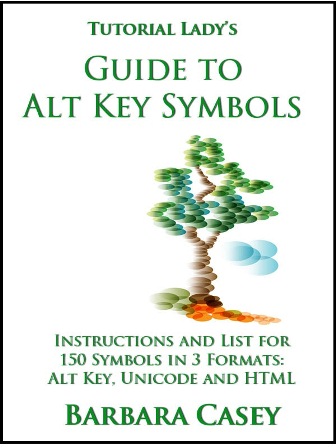How to Make Keyboard Symbols Using Alt Key, HTML and Unicode Characters
Here is a handy list of Alt Key, HTML and Unicode symbols you can make with standard text fonts on your computer keyboard with how-to instructions to make it easy.
It helps if you have a numeric keypad, but if you don’t there are two other methods you can use for making French, Spanish and German accents, copyright symbols, m-dashes, real bullets and oodles more.
Years ago, I started collecting shortcut codes for characters that don’t appear on my computer keyboard. I was publishing print books at the time and really needed to know how to make the copyright sign, a proper ellipsis, bullets, and “n” and “m” dashes.
When I created the first tutorial on my website in 2006, my symbols all used the Alt Key and numeric keypad for Windows computers. I didn’t know much about HTML codes back then.
Over the years, I added to my list of useful shortcuts and eventually had enough to create an extensive tutorial. My tutorial has been on an early version of NewRadiance.com, Squidoo, HubPages, and is now back on my blog.
In this tutorial, you’ll learn how to make cool and useful characters and non-English letters using: (1) the Insert function in Microsoft Word (and Google Docs) and (2) the original Alt Key shortcuts as well as (4) HTML and Unicode signs for the most requested symbols.
Two ways for creating keyboard symbols
1. IN MICROSOFT WORD, YOU CAN USE THE INSERT FUNCTION:
Microsoft Word includes an “insert” function that makes it very easy to add text characters such as copyright, French accents – you name it.
In Word, click on the Insert tab, then click on the symbol icon (at the far right). A small box pops up which shows a few characters and the words “More Symbols.” Click on that and then a bigger box pops up with all kinds of cool characters, depending on which font you have open. Browse the drop-down menu to see what’s available… multiple languages, currency symbols, dingbats… oodles of options.
2. HERE’S HOW TO USE THE NUMERIC KEYPAD, IF YOU HAVE ONE:
Turn on NumLock if it isn’t already selected.
Using the numeric keypad, press the Alt key, and then the numbers (in succession) shown below for the symbol you want to use. For example for © Copyright, hold down Alt, press the number 0, then press the numbers 1, 6, 9. Now you can let up the Alt key.
***LAPTOP USERS***
If you don’t have a numeric keypad, you’ll need to use the insert function… or try the Unicode characters or HTML numeric codes. A number of these are shown below so you can see what works best for you.
The most frequently requested keyboard symbols
Alt Key shortcuts work best with common text fonts: Arial, Courier New and Times New Roman
(1) Creating Alt Key symbols in Windows
Using the numeric keypad on the right side of your keyboard – with NumLock on – press the Alt Key and the numbers shown in succession. After that, let up the Alt Key.
(2) How to insert Unicode characters
First type the capital letter U, then the plus sign (+) and next the numbers and letters shown – in succession. Then you hold down the Alt Key and press lower case letter x. Then let up the Alt Key.
(3) Using HTML Numeric Codes
Type the Ampersand symbol first, followed by the Number sign – – and then type the numbers in order – followed by a semi-colon.
Copyright ©
Alt, 0, 1, 6, 9 for Print
U+00A9 (Alt, x) for Unicode
© followed by ; for HTML
Trademark ™
Alt, 0, 1, 5, 3 for Print
U+2122 (Alt, x) for Unicode
™ followed by ; for HTML
Bullet •
Alt, 0, 1, 4, 9 for Print
U+2022 (Alt, x) for Unicode
• followed by ; for HTML
Ellipsis …
Alt, 0, 1, 3, 3 for Print
U+2026 (Alt, x) for Unicode
… followed by ; for HTML
EM Dash —
Alt, 0, 1, 5, 1 for Print
U+2014 (Alt, x) for Unicode
— followed by ; for HTML
Paragraph (Pilcrow) ¶
Alt, 0, 1, 8, 2 for Print
U+00B6 (Alt, x) for Unicode
¶ followed by ; for HTML
Pound Sign £
Alt 0, 1, 6, 3 for Print
U+00A3 (Alt, x) for Unicode
£ followed by ; for HTML
Cent Sign ¢
Alt, 0, 1, 6, 2 for Print
U+00A2 (Alt, x) for Unicode
¢ followed by ; for HTML
One-half ½
Alt, 0, 1, 8, 9 for Print
U+00BD (Alt, x) for Unicode
½ followed by ; for HTML
French accent a grave – à
Alt, 0, 2, 2, 4 for Print
U+00E0 (Alt, x) for Unicode
à followed by ; for HTML
French accent e grave – è
Alt, 0, 2, 3, 2 for Print
U+00E8 (Alt, x) for Unicode
è followed by ; for HTML
French accent e acute – é
Alt, 0, 2, 3, 3 for Print
U+00E9 (Alt, x) for Unicode
é followed by ; for HTML
Spanish accent n tilde – ñ
Alt, 0, 2, 4, 1 for Print
U+00F1 (Alt, x) for Unicode
ñ followed by ; for HTML
Heart ♥
Alt, 3 for Print
U+2665 (Alt, x) for Unicode
♥ followed by ; for HTML
Degree Sign °
Alt, 0, 1, 7, 6 for Print
U+00B0 (Alt, x) for Unicode
° followed by ; for HTML
♥♥♥♥♥♥♥♥♥♥♥♥
My tutorial with 150 Alt Key Symbols is available on Kindle Unlimited.
♥♥♥♥♥♥♥♥♥♥♥♥
© 2006-2019 Barbara Casey


